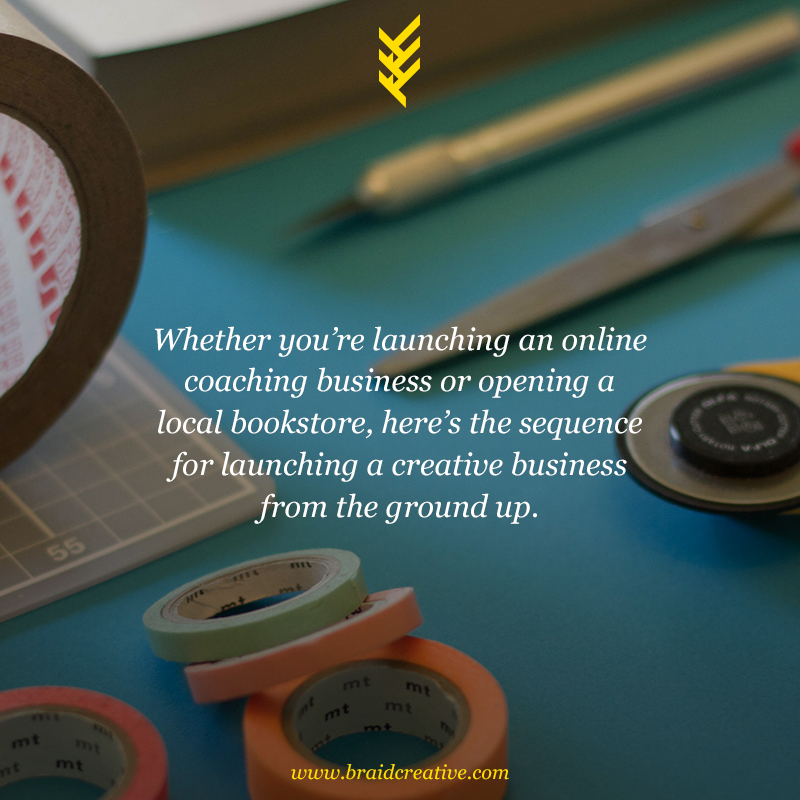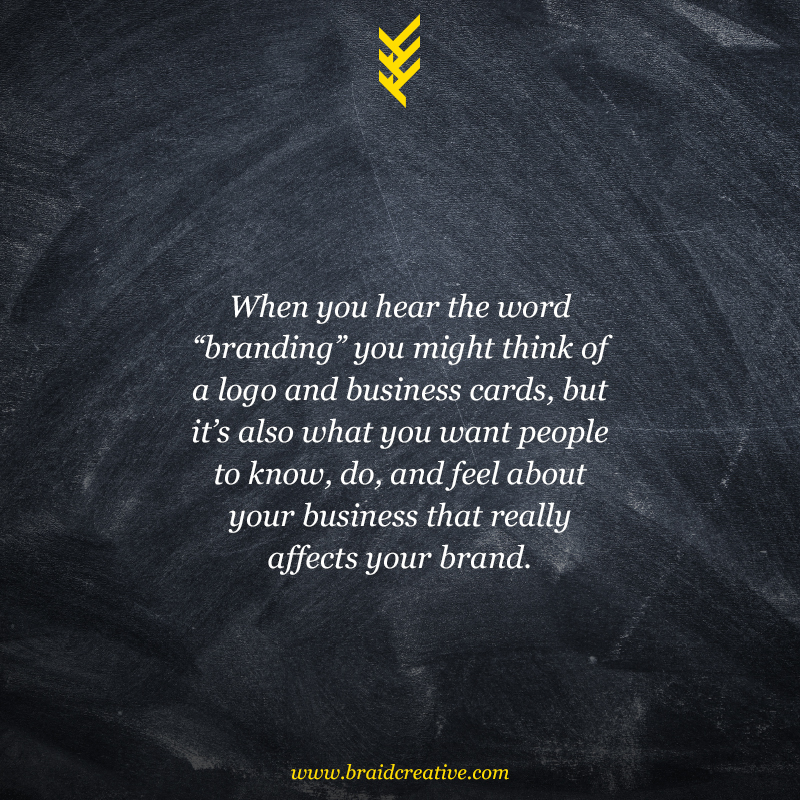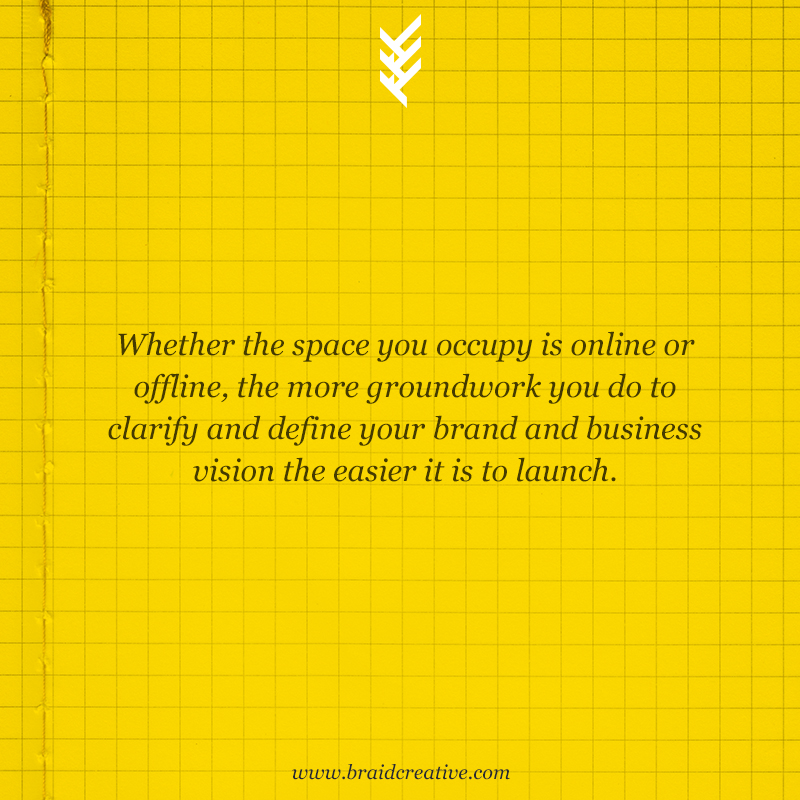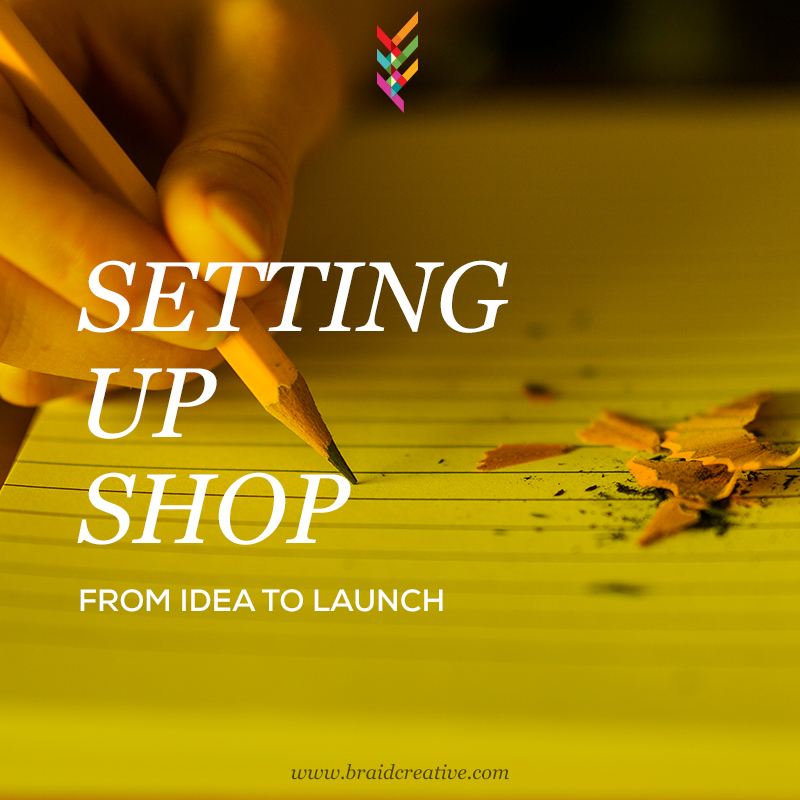I was recently talking shop with my friend and business mentor who is wicked smart and has her finger on the pulse when it comes to all things creative online business – and as we were chatting she confessed that she didn’t entirely understand where the branding process fit in when it comes to launching a new business. We started talking about the order of setting up shop and where branding fits in. I thought, if industry professionals like US were having this clarifying conversation, it might be helpful for those of you who don’t do this for a living to get an idea of what comes first and what you need next before moving forward in launching your creative business.
Whether you’re launching an online coaching business or opening a local bookstore, I’m going to be sharing the sequence I use when launching a creative business from the ground up and hopefully clarify a few questions you might have along the way.

If you like this post and want to hear more, I’ll include links along the way with additional articles and podcast episodes that dig a little deeper. You might start by listening to this bite-sized podcast “minisode” on Being Boss: Setting Up Shop 101.
HOW WILL YOU MAKE MONEY?
When you’re starting a business, the first thing you want to clarify is how you make money. What service, knowledge, skill, or product will you exchange for money? In other words, you need a business plan—and it doesn’t have to be fancy! Here’s a quick fill-in-the-blank model:
I will make money by selling _____(product/skill/service)_____.
It will cost ______ per ______. (This is how you price your product or service.)
If I sell ______ I can make ______ per ______. (This is projected income.)
My expenses will be __________. (Make a list of expenses and costs to run your business.)
If you are opening a business with a lot of projected overhead from the get-go, such as a retail store, it is a good idea to talk with your banker and see if you can get a loan. They’ll walk you through even more business model questions that will help you identify any holes in your business model.
Want to learn more about designing a business model? Listen to Being Boss podcast episode #92 Creating a Business Model with Tara Gentile.
CLARIFY YOUR ROLE(S) IN YOUR BUSINESS
Even if you work all by yourself, it’s important to get super clear on the organizational structure of your business – in other words, what’s your job? And if you are collaborating or partnering with another person or planning on hiring an employee at some point, it’s all the more important to define who does what within your business. I would start by making a list of all the roles involved in your business and the tasks or skills associated with those positions.
For example:
Financials: bookkeeping, payroll, quarterly taxes, budgeting, billing
Creative: writing, designing, making
Project Management: daily to-do, launch planning, organization
Marketing: social media, email, blogging, podcasting, PR pitches
Admin: emails, contracts, marketing implementation
If you’re having a hard time identifying the jobs required for your creative business, just list out every single thing that happens from start to finish for a project. You cannot get too detailed – paying the bills to sending out client contracts to sending that final invoice.
Once you understand the roles involved in getting your business up and running, it is crucial for your own level of happiness to get clear on what role makes you feel most capable within your business (hint: it’s probably the “creative” part of it). The thing you want to be known for is your number one priority and where you should focus the majority of your effort. You can outsource the rest … which brings me to our next step:
In Being Boss podcast episode #62, Emily Thompson and I talk about roles and communication when partnering up in business.
SYSTEMIZE EVERYTHING
It is never too soon to set up systems and processes for how you work in your business. From how often you share content to how you get that content published for the world to see … to how you track your income and expenses or onboard your clients from the moment they express interest in working with you – systemize the work you do. This will help you stay consistent, productive, and focused. It will also make it easier to batch and automate the things that lend themselves toward automation (like social media posts) and outsource the things that need a human being behind them but don’t support your expertise (like responding to email inquiries).
But remember: systems are only as good as the person using them. So while most of your friends use a project management software like Asana or Trello, you might be better served with a simple to-do list in a Google doc.
In Being Boss podcast episode #27, we chat with systems queen, Val Geisler, about organizing your business and processes in a way that works for you and your dream client.
MAKE IT LEGAL AND LEGIT
This is the part of the process that seems to trip up a lot of creative entrepreneurs. If you live in America it’s so easy to open a business bank account and set up an LLC for your business. You can also start to develop contracts to use in client work or set up insurance if you’re opening a brick & mortar store. You can easily DIY this part of the process or you can hire a lawyer and / or accountant to help you along the way. If you’re working with a business partner, this would be a good time to get an operating agreement underway. BUT—and this is a big BUT—don’t let the legal stuff stop you from making the thing you have to sell and doing the work. In all of my businesses this is one of the last things I invested in while setting up shop only because I wanted to start smart and allocate my start-up expenses on things that would help me make money right away – like branding and a website.
In Being Boss podcast episode #73, we chat with our own lawyer, Autumn Witt Boyd, about what you need (and don’t need) when it comes to setting up shop, getting legit, and legally protecting yourself.
GATHER YOUR MATERIALS
Most likely, if you’re a creative entrepreneur, you already have the materials you need to execute your craft. For example, if you’re an artist, you already have your brushes, paints, and canvases. If you’re a designer, you already have your laptop and Pantone swatch book. If you’re launching something like a retail store, now is the time to gather the inventory you’ll need to do business.
If you are offering a service like coaching, you might “gather your materials” by investing in additional training or certification. Read some books and do some research on what will make you the best at your game. But remember, you’re going to have to show up before you’re ready – you can always continue to learn and grow along the way.
In this Being Boss “minisode” we chat more about hiring a coach or mentor who can give you more guidance and help you pinpoint next steps.
START SELLING
It might come as a surprise that selling comes next – before branding, launching, and opening up shop for business. This is because the sooner you can sell what you have to offer, the sooner you will have money in your bank account, feel like a legit business, and have a little confidence under your belt. I recommend you start selling by sending a personal email to your closest friends, peers, colleagues, and clients. Thank them for being a part of your journey and acknowledge the role they’ve played along the way. Then ask them if they or anyone they know might be interested in your offering.
I’d dare to say that this could come first – even before you hammer out your business model. In fact, for most creatives who “stumble” their way into working for themselves, it DOES come first. For example, one of my first freelance projects happened when a blog reader liked my self-designed wedding invitations and asked if I could make some for her too. The transaction was simple, straight-forward, and the beginning of my creative career in working for myself. I didn’t have a bank account, an LLC, or a business plan – and I didn’t need it (yet). The creative came first, then the first transaction, then the business.
Afraid of selling? My good friend Jason Zook wrote an article for on how to get over your fear of selling. Read more here >>
BRANDING AND BUSINESS VISIONING
Branding is how you use words, story, and design (color, images, photographs, and typography) to give your business a memorable identity. A brand package might typically include:
- a logo
- tagline
- brand standards (rules or outline for colors + typography)
- business card design
- signage
- brand elements that can be used in social media
- brand positioning copy
- brand story
- conversation slides for selling what you do

When you hear the word “branding” you might think of a logo and business cards, but it’s also what you want people to know, do, and feel about your business that really affects your brand.
Business visioning is the part of the process where you’re able to take all the ground work you’ve already done and package it up in a way that helps you:
- package your offering and tell a story about why people should hire you
- pinpoint your dream client so you (and they!) know who you’re talking to
- clarify your point-of-view and purpose – the thing you want to really be known for
- confidently explain your approach and what you dream client can expect along the way when they hire you
- find your voice – the tone that differentiate you from your competition
If you’re working with a professional branding agency, like us here at Braid Creative, you will go through a collaborative and methodical process, a bit like “brand therapy” – we call it The Braid Method. It’s a series of branding exercises and facilitated conversations where you’re a part of the process. It’s how we create a brand that helps you clarify and package together who you are and what you do into a simple, articulate, and super-visual brand platform.
In Being Boss podcast episode #56, we have our very own Tara Street chatting with us about owning your expertise (even if you’re a beginner!).
YOUR WEBSITE / YOUR SPACE
If you’ve gone through a process like The Braid Method, you already have an arsenal of graphics and content a web designer can use to create your website. However, they’ll want to take you through their own process to understand the primary purpose of your website, how your user will engage with your online space, and the kind of functionality you want to include – from a blog to eCommerce all of those things are taken into consideration when building out a site.
If you have a physical store front or office, this is the part of the process where you’ll begin bringing the look and feel of your brand into your offline space. The furniture you pick, the colors you paint, and the choices you make when designing your physical space can be inspired by all the branding work you’ve already done. Our clients with physical spaces will share the packaged branding documents we’ve created with their architect or interior designer so they understand the brand and business vision.

Whether the space you occupy is online or offline, the more groundwork you do to clarify and define your brand and business vision, the easier it is to launch. If you’re missing the foundation of who you are, what you do, and the look and feel of your business, it’s going to become glaringly obvious during the building phase of your website or storefront.
In one of our earliest episodes of Being Boss, website & online business guru, Emily Thompson, and I chat about how your website is your most valuable employee.
LAUNCH!
Phew! You’ve done a lot of work, but it’s not over yet. Now you need to launch and celebrate all your hard work! It’s time to send emails, publish content, and saturate your social media feeds with the fact that YOU HAVE ARRIVED and are ready for hire.
In Being Boss podcast episode #63, we talk about what goes into a launch—a must listen.
AND KEEP WORKING…
After launching, you can feel like your work is done… but it’s really only the beginning. You have to keep publishing, marketing, and curating client work that you can show off and share. The great news is, the more clarity you have around where you started and where you’re going, the more focus you’ll have along the way. Your brand and business vision will continue to grow and evolve as you get more work under your belt.
One of my favorite posts was written by Tara where she explains the content you create often shapes your expertise and the work you continue to do. Read that here >>
P.S. I’ve included a branding exercise worksheet that will help you clarify your creative process, which is just one part of getting clarity around what you do when you’re setting up shop.
DOWNLOAD THE STEPS YOU TAKE WORKSHEET – NO EMAIL REQUIRED!
And if you would like to get our articles, worksheets, and checklists straight to your inbox subscribe to our newsletter below.

